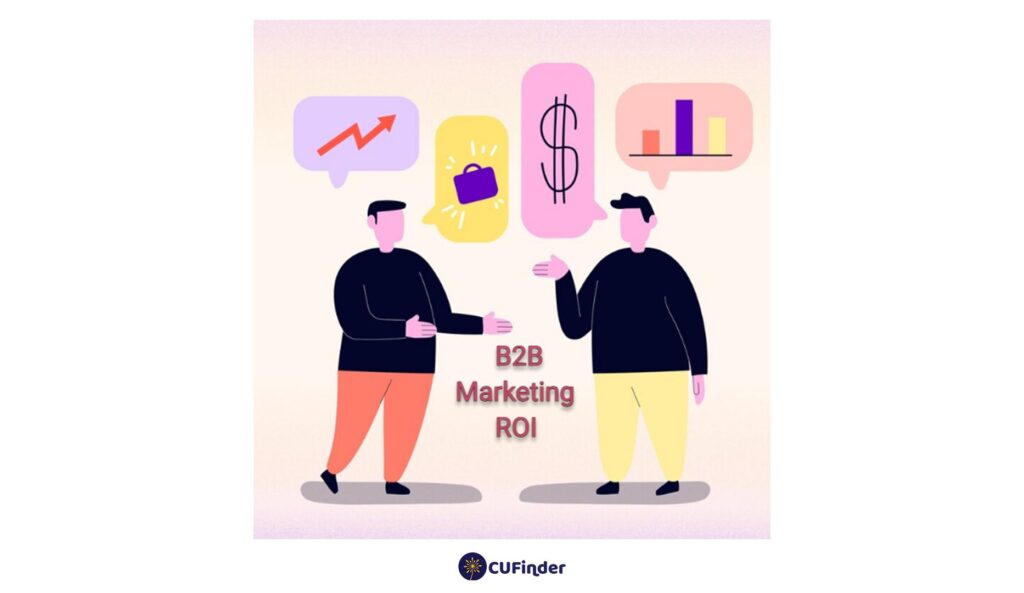Welcome to the ultimate guide on B2B Marketing ROI Benchmarks.
In the ever-evolving world of B2B marketing, staying ahead of the curve is crucial.
One of the key aspects of this is understanding and optimizing your Return on Investment (ROI).
B2B marketing ROI benchmarks are key indicators used to evaluate the effectiveness and profitability of marketing investments. While these benchmarks can vary widely depending on the industry, target market, and specific marketing channels used, a general rule of thumb is an ROI of 5:1, considered a good return, meaning that for every dollar spent, five dollars in revenue is generated.
This guide will delve into B2B marketing ROI benchmarks, providing clear insights and actionable steps for businesses looking to maximize their returns.
So, let’s get started!
What Is B2B Marketing ROI?

B2B marketing ROI is a key performance indicator that measures the profitability of your marketing efforts in the world of B2B marketing.
It’s essentially a metric that tells you how effective your marketing strategies are in generating revenue and profits.
At its core, B2B marketing ROI quantifies the financial gain or loss achieved as a result of your marketing activities.
This includes all the investments made in marketing, such as
- advertising,
- content creation, and
- marketing technology, weighed against the revenue generated from those investments.
In simpler terms, ROI in B2B marketing answers the fundamental question: “Is our marketing strategy making us money or costing us money?”
Understanding your ROI is essential for making informed decisions and optimizing your marketing efforts.
What Are B2B Marketing ROI Benchmarks?

B2B marketing ROI benchmarks are reference points or standards. They help you assess the performance of your marketing activities in comparison to industry or peer averages.
These benchmarks provide invaluable insights into how your marketing ROI measures up against others in your sector.
Benchmarking your B2B marketing ROI allows you to:
1. Set Realistic Goals:
By knowing what is achievable within your industry, you can set more realistic and achievable marketing goals.
2. Identify Areas for Improvement:
Comparing your performance to benchmarks helps you pinpoint areas where your marketing efforts may be falling short.
3. Measure Progress:
Benchmarks help you track your progress over time and determine if your ROI is improving or declining.
4. Optimize Budget Allocation:
Understanding how your ROI compares to industry standards can help you allocate your marketing budget more effectively.
How do you calculate B2B marketing ROI for B2B businesses?

Now that you understand what B2B marketing ROI is let’s delve into how you can calculate it specifically for B2B businesses.
Here’s a simple formula to get you started:
B2B marketing ROI = (Net Profit from Marketing – Marketing Investment) / Marketing Investment x 100
Let’s break down the components of this formula:
1. Net Profit from Marketing:
This represents the revenue generated as a direct result of your marketing efforts.
It’s essential to track revenue specifically attributed to your marketing campaigns.
2. Marketing Investment:
This encompasses all the costs associated with your marketing activities, including
- advertising spend,
- content creation costs,
- marketing software subscriptions, and
- staff salaries dedicated to marketing.
Once you have these numbers, subtract your marketing investment from your net profit from marketing.
Then, divide the result by your marketing investment and multiply by 100 to express the ROI as a percentage.
Calculating ROI with an Example:

Let’s say you run a B2B SaaS company and invest $10,000 in a digital marketing campaign.
From this campaign, you generate $50,000 in revenue.
Your net profit is $40,000 ($50,000 – $10,000), and your marketing investment is $10,000.
Applying the formula:
ROI = [($40,000 – $10,000) / $10,000] x 100
ROI = ($30,000 / $10,000) x 100
ROI = 300%
In this scenario, your ROI is 300%, meaning you’ve gained $3 for every $1 spent on B2B SaaS marketing.
The Best Ways to Measure Your B2B Marketing ROI

Now that you know how to calculate B2B marketing ROI, let’s explore the best ways to measure it effectively and gain valuable insights to improve your marketing strategies:
1. Utilize Marketing Metrics:
To measure ROI accurately, you need to track various marketing metrics, such as
- leads generated,
- conversion rates,
- Customer Acquisition Costs (CAC), and
- Customer Lifetime Value (CLTV).
These metrics provide a holistic view of your marketing performance.
2. Implement Conversion Tracking:
Implement conversion tracking tools like Google Analytics or marketing automation software to monitor the effectiveness of your marketing channels.
This will help you attribute revenue to specific campaigns and channels.
3. Establish Clear Goals:
Define specific, measurable, and achievable goals for your marketing campaigns.
Setting clear objectives will make it easier to determine whether your efforts are delivering the desired results.
4. Segment Your Audience:
Segmenting your audience allows you to tailor your marketing efforts to specific customer groups.
By analyzing the ROI of each segment, you can allocate resources more efficiently.

5. Consider the B2B Content Marketing Funnel:
Recognize that B2B marketing often involves a longer and more complex sales cycle.
The B2B content marketing funnel involves creating content that aligns with different stages of the B2B buyer’s journey (sales funnel), from awareness to consideration to decision.
Measure the ROI of content at each stage of the sales funnel.
6. Analyze Marketing Channels:
Evaluate the performance of various marketing channels (e.g., email marketing, social media, SEO, PPC advertising).
Identify which channels are delivering the highest ROI and allocate more resources to them.
7. Regularly Review and Adjust:
Marketing ROI is not static; it evolves over time.
Regularly review your ROI metrics, benchmarks, and strategies to identify opportunities for improvement.
Be ready to adjust your marketing efforts accordingly.
8. Invest in Marketing Measurement Tools:
Consider investing in marketing measurement software, marketing institutes, or top B2B marketing agencies like CUFinder that provide comprehensive insights into your ROI.
These tools can streamline data collection and analysis, making it easier to track and optimize your performance.

Final Thoughts
Understanding and optimizing B2B marketing ROI benchmarks is essential for B2B businesses seeking to thrive in the competitive digital landscape.
By calculating your ROI accurately and comparing it to industry benchmarks, you can
- make data-driven decisions,
- set realistic goals, and
- continually refine your marketing strategies.
Remember that B2B marketing ROI is not a one-time calculation but an ongoing process.
Regularly measuring, analyzing, and adjusting your marketing efforts will lead to better returns and sustained growth.
In the world of B2B marketing, staying ahead of the curve requires a commitment to data-driven decision-making and a keen focus on optimizing your marketing ROI.
So, embrace the power of ROI metrics, leverage the B2B content marketing funnel, and make the most of your marketing channels to achieve remarkable results. Your journey to mastering B2B marketing ROI benchmarks begins now.
